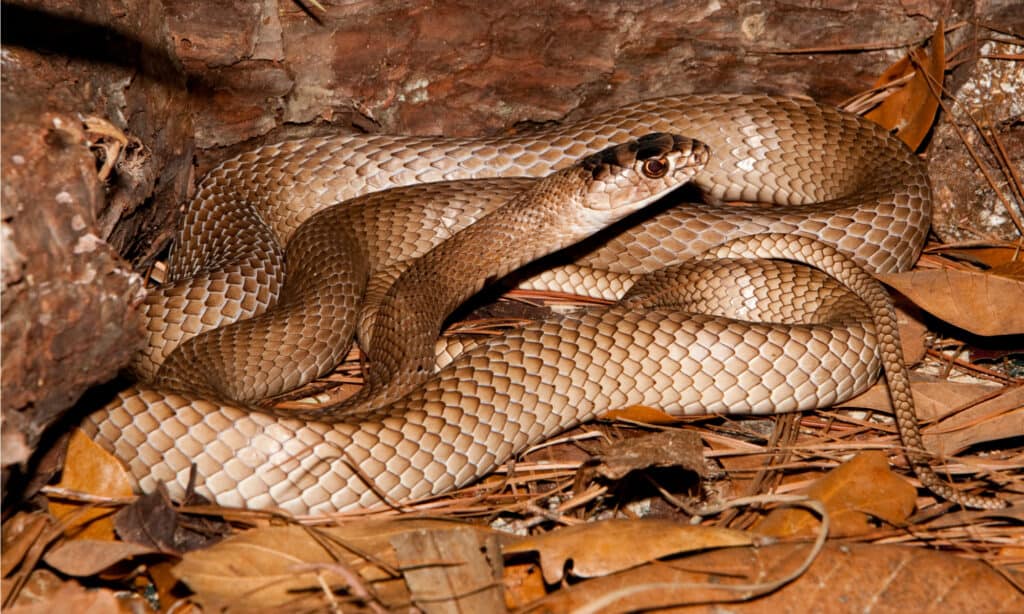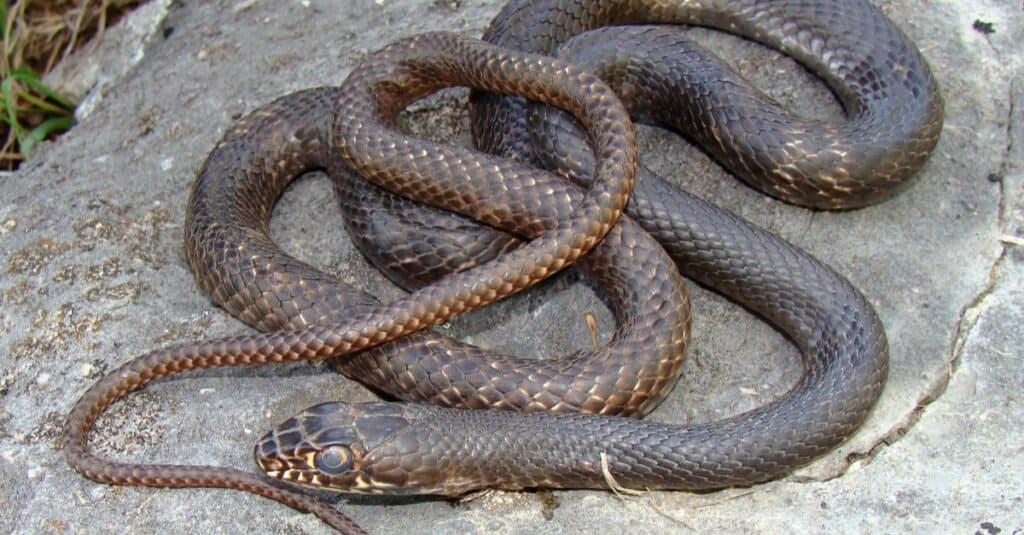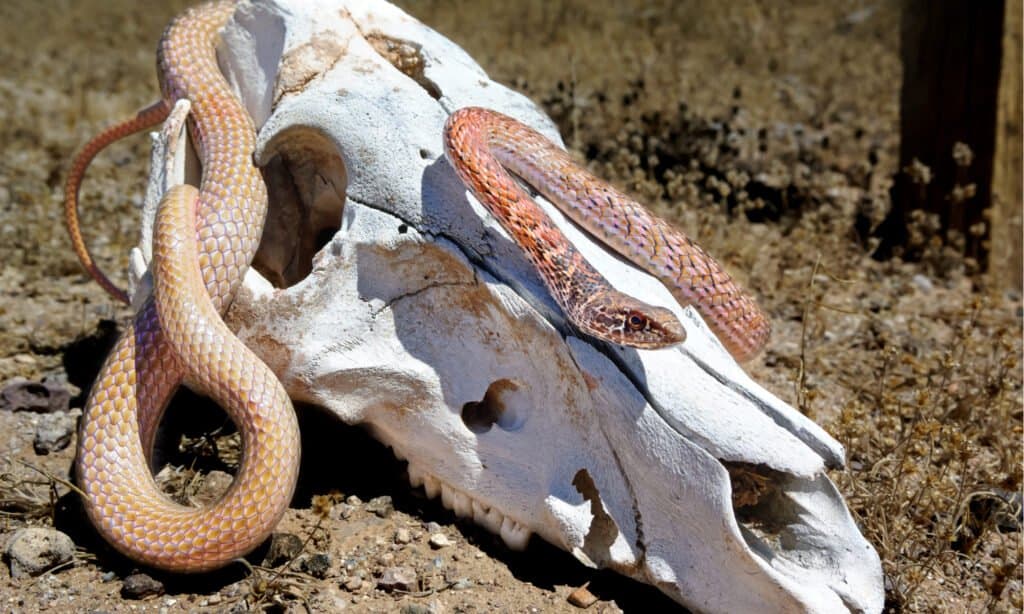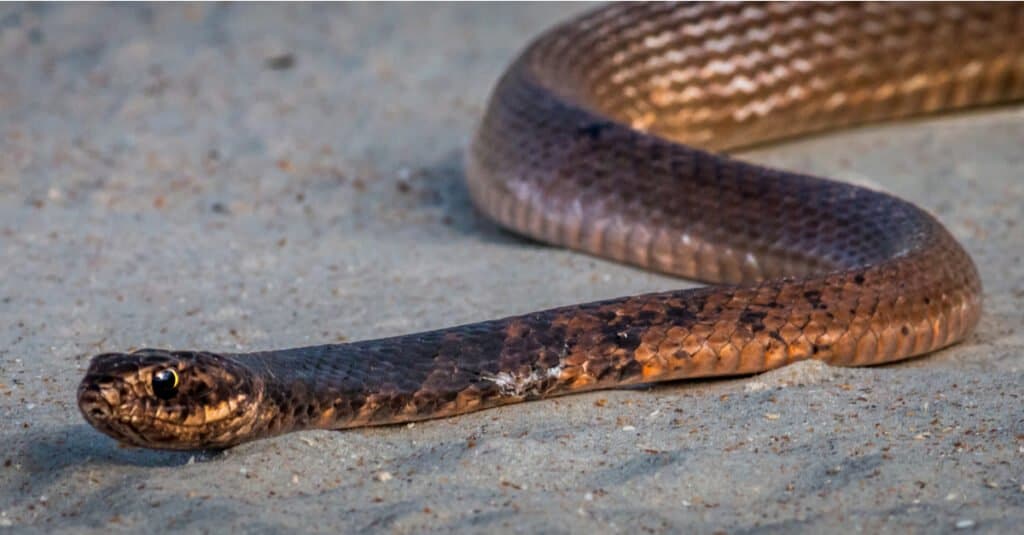The coachwhip is a thin snake with a long body and large eyes. The scientific name for this snake is Masticophis flagellum. It is a nonvenomous snake that belongs to the Colubridae family, one of the largest snake families! This snake is native to North America and has six other subspecies. It has often been labeled as aggressive when, actually, it is just very curious by nature.
These snakes are called coachwhips mostly due to the braiding pattern of their scales. However, a myth suggests that these snakes are prone to chasing humans and whipping them with their tails. Although this myth has been debunked, expect its quick body to reach up to four miles per hour in speed! As for size, coachwhip snakes can range anywhere from 4 to 6 feet in length. As a result, they can seem quite intimidating. So, what is the largest coachwhip snake to be recorded? Let’s look!
Largest Coachwhip Snake Ever Recorded

The eastern coachwhip is the largest coachwhip snake ever recorded, totaling 8.5 feet in length.
©Jay Ondreicka/Shutterstock.com
The largest size recorded for the coachwhip snake was of the eastern subspecies, totaling 8.5 feet in length! Juvenile coachwhip snakes typically reach just over 40 inches in length and can weigh up to 24 ounces. Adult coachwhip snakes range from 50 to 72 inches in length. They can weigh anywhere from 2 to 3.5 pounds. For a North American native snake, this is quite large!
More on Coachwhip Snakes
Appearance and Behavior

Coachwhip snakes are non-aggressive snakes found in South America.
©Matt Jeppson/Shutterstock.com
Coachwhip snakes are thin snakes. Their head is relatively small and is donned with big eyes and large, round pupils. Their body can appear as thick as a thumb, while their tail is as thin as a whip, and perhaps even as strong as one too! These snakes tend to vary in color; however, all of them have a very distinct braiding pattern. While most of them are dark with tan skin, some of the coachwhip subspecies can be lighter in color. Others can even be red, such as the red racer, western coachwhip, and the Sonoran coachwhip.
Because these snakes have large eyes in proportion to their relatively small head size, their eyesight is particularly good. This helps them hunt because they typically catch their prey by raising their heads and hunting above land. When it comes to their behavior, they are curious but are actually nervous. They tend to flee rather than strike unless, of course, a threatening predator is nearby. When a coachwhip feels threatened and cannot escape, expect it to vibrate its tail and deliver a series of hissing sounds.
Habitat

Coachwhip snakes are curious snakes who love being out in the daytime.
©Deep Desert Photography/Shutterstock.com
The coachwhip snakes tend to live in dry, sandy areas such as deserts, scrublands, sandhills, and grasslands. They are also prone to climbing trees, shrubs, and rocks. You can even expect to see them inside forests and old fields. The coachwhip snake and its subspecies are active during daylight hours. They prefer to be out on hot, sunny days while other snakes remain hidden. When it’s nighttime or when the temperature drops, these snakes often find refuge under coverings or burrow themselves. They are typically found in the southern area of the United States and in Mexico; however, some of the subspecies can be found in the Carolinas and even central California.
Eastern coachwhips will likely be found in states such as Georgia and Texas. Their colors range from black to tan. Red coachwhips or red racers can likely be found in southern California. Lined coachwhips, however, can more than likely be found in the southern part of Mexico. The coachwhip snake and its subspecies all vary in color as well. However, most of them have a similar braiding type design on their scales. If you can tell where the braiding overlaps, it may help you distinguish what kind of coachwhip snake you have found.
Diet

Coachwhips hunt by sight, striking at their prey and swallowing it whole.
©Patrick K. Campbell/Shutterstock.com
Coachwhip snakes primarily eat insects, small birds, lizards, small rodents, and other snakes. Because these snakes are extremely fast, they can also chase down skinks and even the fastest of the lizards, the racerunner. Although the coachwhip snake is in the same family of many constrictors, this snake does not coil around and squeeze its prey. In fact, it hunts by sight with its tiny head held high, striking at its prey and delivering a large bite to stun it. Then, it will eat its prey while it’s still alive.
Danger

Coachwhip snakes are non-aggressive and nonvenomous.
©Barry James Davis/Shutterstock.com
Although there are many myths that say otherwise, the coachwhip and its subspecies do not pose a threat to humans or large domestic pets. In fact, since this snake is nervous by nature, it will often try to flee when it perceives a threat. If you happen to catch one, it is likely to fall limp, while some may strike and deliver a painful bite. Do not worry if you are bitten by a coachwhip, as this snake is not venomous, and the only way the bite should cause concern to you is if it has become infected.
Subspecies
There are six verified subspecies for the Masticophis flagellum:
- Sonoran Coachwhip
- Eastern Coachwhip
- Lined Coachwhip
- Red Coachwhip (or Red Racer)
- San Joaquin Coachwhip
- Western Coachwhip
Even though they are all named differently, their characteristics, habitats, and attitudes are remarkably similar.
Conclusion

Coachwhip snakes are neither threatened nor endangered.
©Alexander Wong/Shutterstock.com
Thankfully, despite climate change and its current disasters, this snake is not threatened or endangered. In fact, it thrives in the wild and prefers hot weather, along with its subspecies. Although the state of Illinois may say otherwise, the reason this snake is listed on the list of endangered species is because of habitat clearing and traffic accidents. Overall, this species is one of the least to be concerned about when it comes to being endangered. Although coachwhip snakes tend to flee when approached by a human, still proceed with caution if you ever come close to one of these thin-bodied fellows.
Other Record-Breaking Snakes

©Valt Ahyppo/Shutterstock.com
Scarlet kingsnakes are a species of nonvenomous snake that is known for their striking colors and patterns. They have bright red, black, and yellow bands that run the length of their body. These snakes can be found in various habitats, such as forests, fields, and rocky areas throughout the southern United States.
The largest scarlet kingsnake ever recorded was an impressive 28 inches long! This record-breaking snake was discovered in Georgia during the 1950s. While this may seem like a large size for a scarlet kingsnake, it is actually relatively small compared to other types of snakes.
Despite not being particularly big in size compared to other snakes, scarlet kingsnakes play an important role in their ecosystems. As predators of small rodents and insects, they help keep these populations under control. Additionally, they serve as prey for larger animals, such as birds of prey or mammals like raccoons or coyotes.
The photo featured at the top of this post is © Jay Ondreicka/Shutterstock.com
Discover the "Monster" Snake 5X Bigger than an Anaconda
Every day A-Z Animals sends out some of the most incredible facts in the world from our free newsletter. Want to discover the 10 most beautiful snakes in the world, a "snake island" where you're never more than 3 feet from danger, or a "monster" snake 5X larger than an anaconda? Then sign up right now and you'll start receiving our daily newsletter absolutely free.
Thank you for reading! Have some feedback for us? Contact the AZ Animals editorial team.






